Evaluation of Financial Performance and Position of Clariton Antiques
VerifiedAdded on 2020/01/28
|20
|6208
|80
Report
AI Summary
This report provides a comprehensive financial analysis of Clariton Antiques Ltd., a retail business specializing in antiquities. The analysis encompasses various aspects of financial management, including identifying and assessing sources of finance such as bank loans, hire-purchase agreements, and venture capital. It evaluates the costs associated with these sources, emphasizing the importance of financial planning, budgeting, and understanding the information needs of different stakeholders, like partners and venture capitalists. The report delves into the impact of financial decisions on financial statements, analyzes cash budgets, and explores investment appraisal techniques to assess project viability. Furthermore, it examines key components of financial statements, compares different formats, and analyzes financial ratios to evaluate the company's performance over time. The report aims to provide a holistic view of Clariton Antiques' financial position and offer insights for strategic decision-making.

STUDENT NAME:
STUDENT ID:
ASSIGNMENT ID:
ASSIGNMENT TITLE: EVALUATION OF FINANCIAL
PERFORMACE AND POSITION
1
STUDENT ID:
ASSIGNMENT ID:
ASSIGNMENT TITLE: EVALUATION OF FINANCIAL
PERFORMACE AND POSITION
1
Paraphrase This Document
Need a fresh take? Get an instant paraphrase of this document with our AI Paraphraser
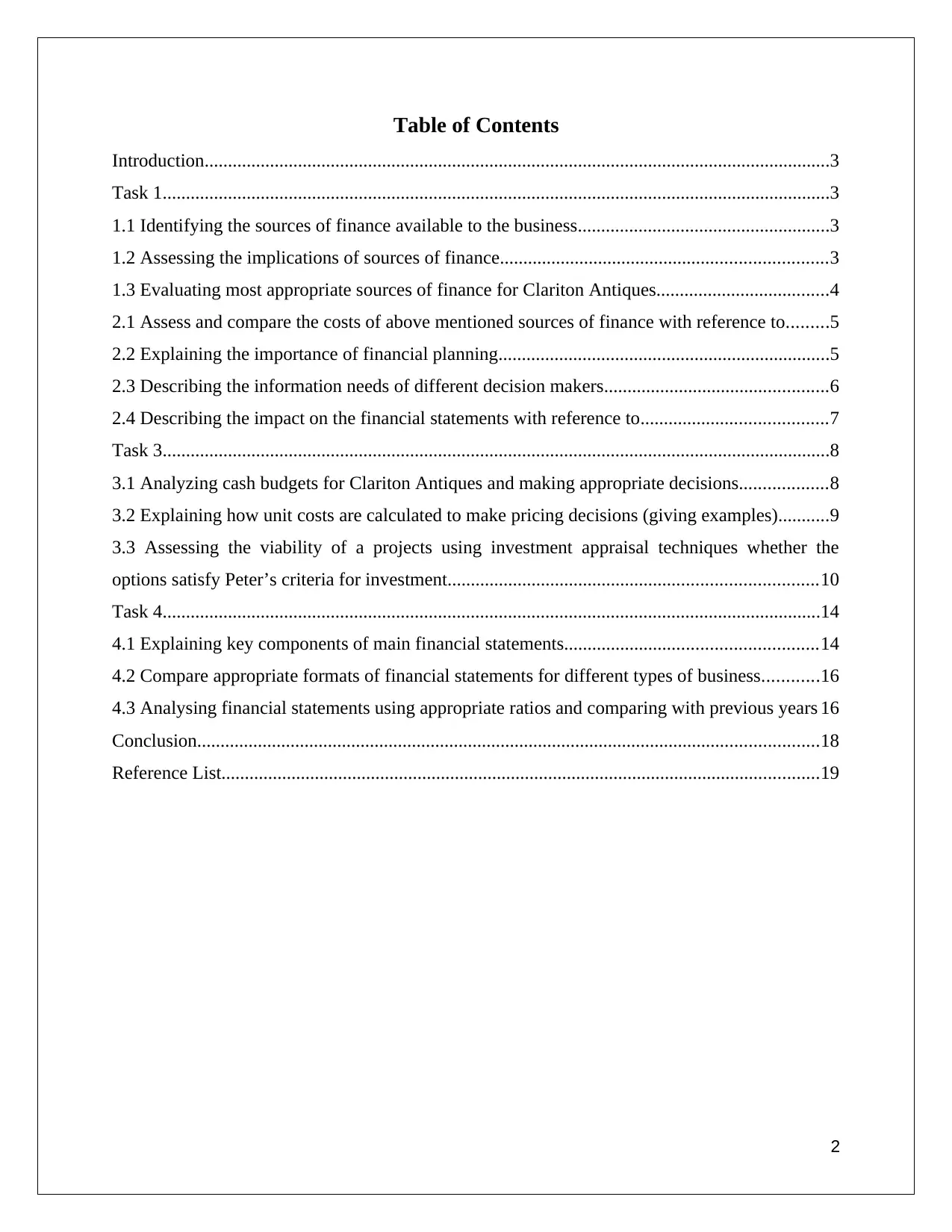
Table of Contents
Introduction......................................................................................................................................3
Task 1...............................................................................................................................................3
1.1 Identifying the sources of finance available to the business......................................................3
1.2 Assessing the implications of sources of finance......................................................................3
1.3 Evaluating most appropriate sources of finance for Clariton Antiques.....................................4
2.1 Assess and compare the costs of above mentioned sources of finance with reference to.........5
2.2 Explaining the importance of financial planning.......................................................................5
2.3 Describing the information needs of different decision makers................................................6
2.4 Describing the impact on the financial statements with reference to........................................7
Task 3...............................................................................................................................................8
3.1 Analyzing cash budgets for Clariton Antiques and making appropriate decisions...................8
3.2 Explaining how unit costs are calculated to make pricing decisions (giving examples)...........9
3.3 Assessing the viability of a projects using investment appraisal techniques whether the
options satisfy Peter’s criteria for investment...............................................................................10
Task 4.............................................................................................................................................14
4.1 Explaining key components of main financial statements......................................................14
4.2 Compare appropriate formats of financial statements for different types of business............16
4.3 Analysing financial statements using appropriate ratios and comparing with previous years 16
Conclusion.....................................................................................................................................18
Reference List................................................................................................................................19
2
Introduction......................................................................................................................................3
Task 1...............................................................................................................................................3
1.1 Identifying the sources of finance available to the business......................................................3
1.2 Assessing the implications of sources of finance......................................................................3
1.3 Evaluating most appropriate sources of finance for Clariton Antiques.....................................4
2.1 Assess and compare the costs of above mentioned sources of finance with reference to.........5
2.2 Explaining the importance of financial planning.......................................................................5
2.3 Describing the information needs of different decision makers................................................6
2.4 Describing the impact on the financial statements with reference to........................................7
Task 3...............................................................................................................................................8
3.1 Analyzing cash budgets for Clariton Antiques and making appropriate decisions...................8
3.2 Explaining how unit costs are calculated to make pricing decisions (giving examples)...........9
3.3 Assessing the viability of a projects using investment appraisal techniques whether the
options satisfy Peter’s criteria for investment...............................................................................10
Task 4.............................................................................................................................................14
4.1 Explaining key components of main financial statements......................................................14
4.2 Compare appropriate formats of financial statements for different types of business............16
4.3 Analysing financial statements using appropriate ratios and comparing with previous years 16
Conclusion.....................................................................................................................................18
Reference List................................................................................................................................19
2
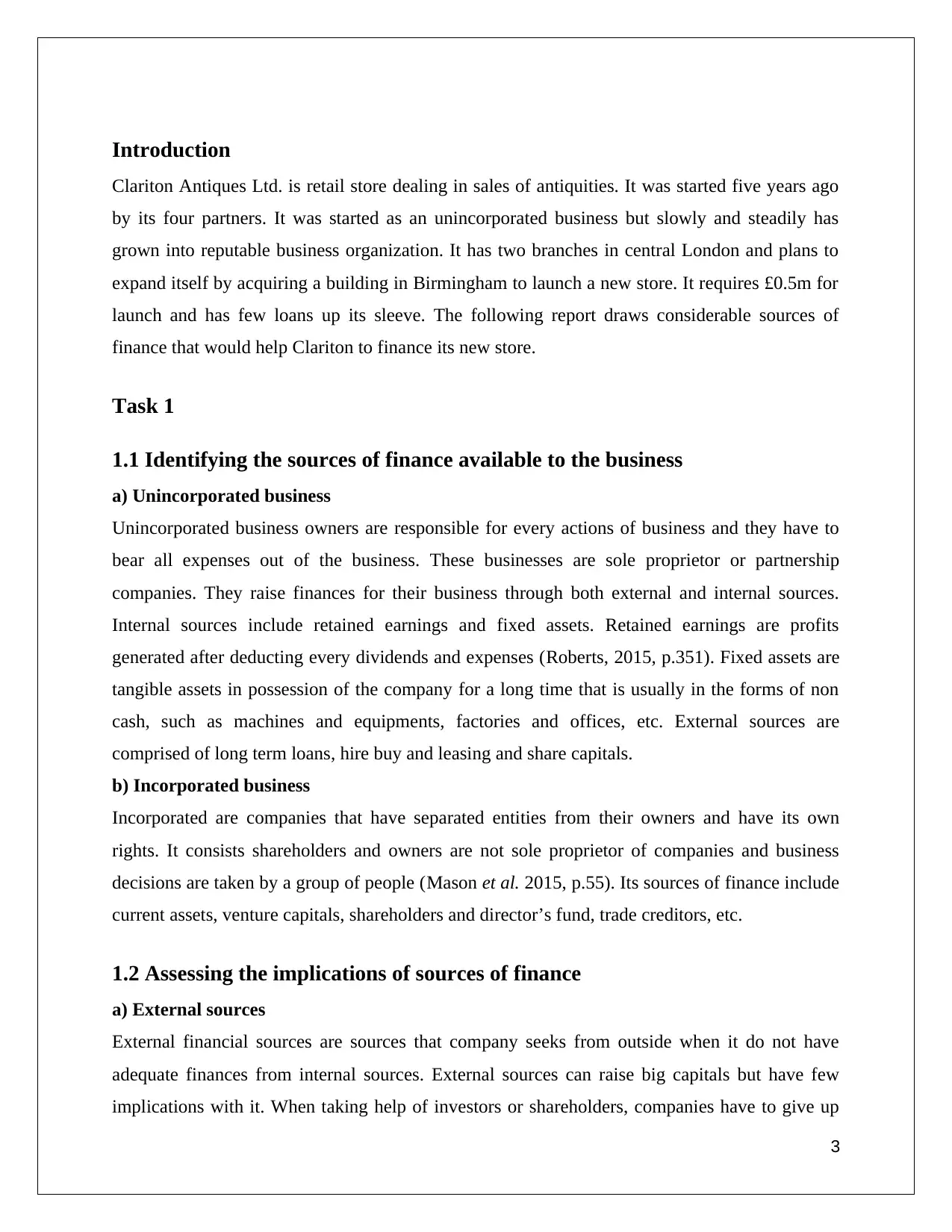
Introduction
Clariton Antiques Ltd. is retail store dealing in sales of antiquities. It was started five years ago
by its four partners. It was started as an unincorporated business but slowly and steadily has
grown into reputable business organization. It has two branches in central London and plans to
expand itself by acquiring a building in Birmingham to launch a new store. It requires £0.5m for
launch and has few loans up its sleeve. The following report draws considerable sources of
finance that would help Clariton to finance its new store.
Task 1
1.1 Identifying the sources of finance available to the business
a) Unincorporated business
Unincorporated business owners are responsible for every actions of business and they have to
bear all expenses out of the business. These businesses are sole proprietor or partnership
companies. They raise finances for their business through both external and internal sources.
Internal sources include retained earnings and fixed assets. Retained earnings are profits
generated after deducting every dividends and expenses (Roberts, 2015, p.351). Fixed assets are
tangible assets in possession of the company for a long time that is usually in the forms of non
cash, such as machines and equipments, factories and offices, etc. External sources are
comprised of long term loans, hire buy and leasing and share capitals.
b) Incorporated business
Incorporated are companies that have separated entities from their owners and have its own
rights. It consists shareholders and owners are not sole proprietor of companies and business
decisions are taken by a group of people (Mason et al. 2015, p.55). Its sources of finance include
current assets, venture capitals, shareholders and director’s fund, trade creditors, etc.
1.2 Assessing the implications of sources of finance
a) External sources
External financial sources are sources that company seeks from outside when it do not have
adequate finances from internal sources. External sources can raise big capitals but have few
implications with it. When taking help of investors or shareholders, companies have to give up
3
Clariton Antiques Ltd. is retail store dealing in sales of antiquities. It was started five years ago
by its four partners. It was started as an unincorporated business but slowly and steadily has
grown into reputable business organization. It has two branches in central London and plans to
expand itself by acquiring a building in Birmingham to launch a new store. It requires £0.5m for
launch and has few loans up its sleeve. The following report draws considerable sources of
finance that would help Clariton to finance its new store.
Task 1
1.1 Identifying the sources of finance available to the business
a) Unincorporated business
Unincorporated business owners are responsible for every actions of business and they have to
bear all expenses out of the business. These businesses are sole proprietor or partnership
companies. They raise finances for their business through both external and internal sources.
Internal sources include retained earnings and fixed assets. Retained earnings are profits
generated after deducting every dividends and expenses (Roberts, 2015, p.351). Fixed assets are
tangible assets in possession of the company for a long time that is usually in the forms of non
cash, such as machines and equipments, factories and offices, etc. External sources are
comprised of long term loans, hire buy and leasing and share capitals.
b) Incorporated business
Incorporated are companies that have separated entities from their owners and have its own
rights. It consists shareholders and owners are not sole proprietor of companies and business
decisions are taken by a group of people (Mason et al. 2015, p.55). Its sources of finance include
current assets, venture capitals, shareholders and director’s fund, trade creditors, etc.
1.2 Assessing the implications of sources of finance
a) External sources
External financial sources are sources that company seeks from outside when it do not have
adequate finances from internal sources. External sources can raise big capitals but have few
implications with it. When taking help of investors or shareholders, companies have to give up
3
⊘ This is a preview!⊘
Do you want full access?
Subscribe today to unlock all pages.

Trusted by 1+ million students worldwide
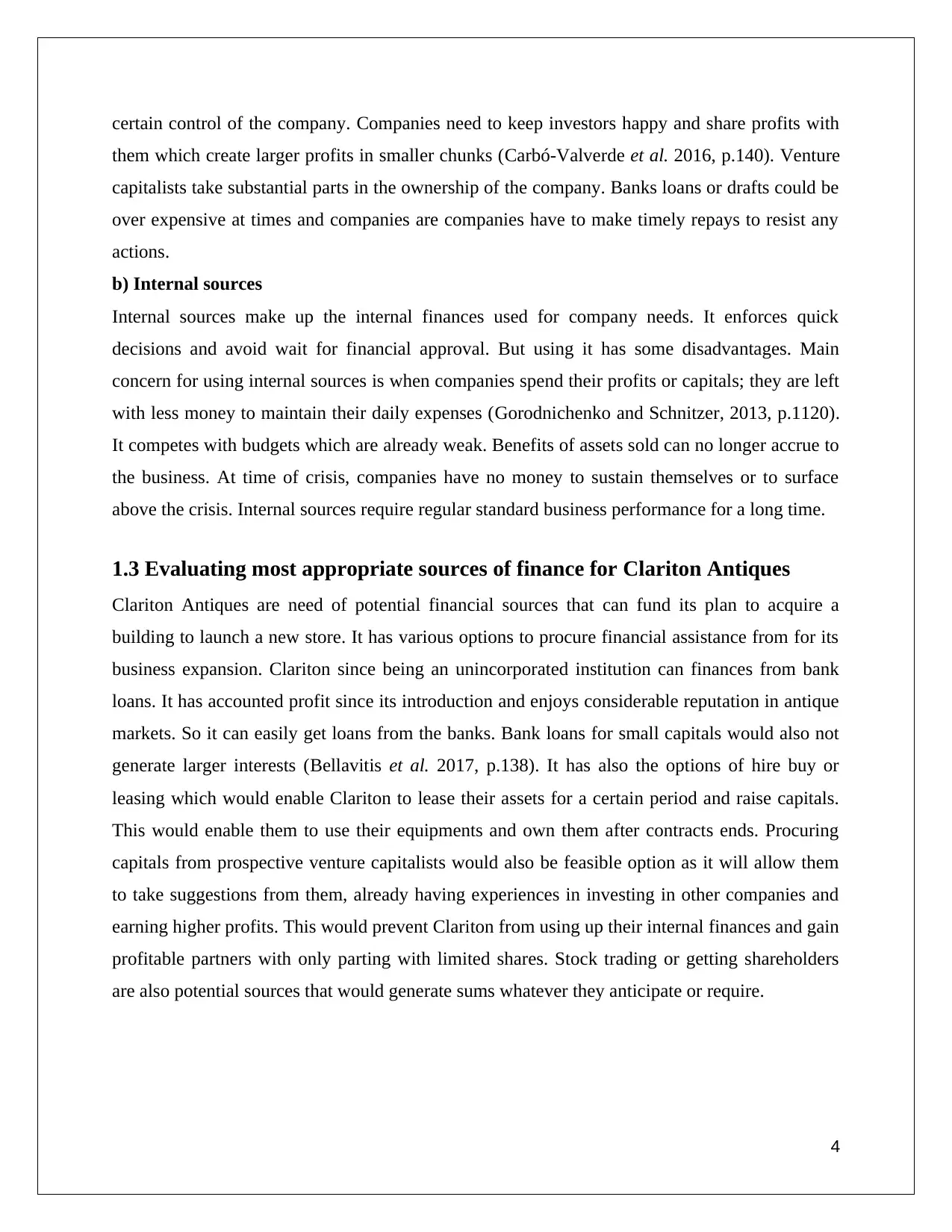
certain control of the company. Companies need to keep investors happy and share profits with
them which create larger profits in smaller chunks (Carbó‐Valverde et al. 2016, p.140). Venture
capitalists take substantial parts in the ownership of the company. Banks loans or drafts could be
over expensive at times and companies are companies have to make timely repays to resist any
actions.
b) Internal sources
Internal sources make up the internal finances used for company needs. It enforces quick
decisions and avoid wait for financial approval. But using it has some disadvantages. Main
concern for using internal sources is when companies spend their profits or capitals; they are left
with less money to maintain their daily expenses (Gorodnichenko and Schnitzer, 2013, p.1120).
It competes with budgets which are already weak. Benefits of assets sold can no longer accrue to
the business. At time of crisis, companies have no money to sustain themselves or to surface
above the crisis. Internal sources require regular standard business performance for a long time.
1.3 Evaluating most appropriate sources of finance for Clariton Antiques
Clariton Antiques are need of potential financial sources that can fund its plan to acquire a
building to launch a new store. It has various options to procure financial assistance from for its
business expansion. Clariton since being an unincorporated institution can finances from bank
loans. It has accounted profit since its introduction and enjoys considerable reputation in antique
markets. So it can easily get loans from the banks. Bank loans for small capitals would also not
generate larger interests (Bellavitis et al. 2017, p.138). It has also the options of hire buy or
leasing which would enable Clariton to lease their assets for a certain period and raise capitals.
This would enable them to use their equipments and own them after contracts ends. Procuring
capitals from prospective venture capitalists would also be feasible option as it will allow them
to take suggestions from them, already having experiences in investing in other companies and
earning higher profits. This would prevent Clariton from using up their internal finances and gain
profitable partners with only parting with limited shares. Stock trading or getting shareholders
are also potential sources that would generate sums whatever they anticipate or require.
4
them which create larger profits in smaller chunks (Carbó‐Valverde et al. 2016, p.140). Venture
capitalists take substantial parts in the ownership of the company. Banks loans or drafts could be
over expensive at times and companies are companies have to make timely repays to resist any
actions.
b) Internal sources
Internal sources make up the internal finances used for company needs. It enforces quick
decisions and avoid wait for financial approval. But using it has some disadvantages. Main
concern for using internal sources is when companies spend their profits or capitals; they are left
with less money to maintain their daily expenses (Gorodnichenko and Schnitzer, 2013, p.1120).
It competes with budgets which are already weak. Benefits of assets sold can no longer accrue to
the business. At time of crisis, companies have no money to sustain themselves or to surface
above the crisis. Internal sources require regular standard business performance for a long time.
1.3 Evaluating most appropriate sources of finance for Clariton Antiques
Clariton Antiques are need of potential financial sources that can fund its plan to acquire a
building to launch a new store. It has various options to procure financial assistance from for its
business expansion. Clariton since being an unincorporated institution can finances from bank
loans. It has accounted profit since its introduction and enjoys considerable reputation in antique
markets. So it can easily get loans from the banks. Bank loans for small capitals would also not
generate larger interests (Bellavitis et al. 2017, p.138). It has also the options of hire buy or
leasing which would enable Clariton to lease their assets for a certain period and raise capitals.
This would enable them to use their equipments and own them after contracts ends. Procuring
capitals from prospective venture capitalists would also be feasible option as it will allow them
to take suggestions from them, already having experiences in investing in other companies and
earning higher profits. This would prevent Clariton from using up their internal finances and gain
profitable partners with only parting with limited shares. Stock trading or getting shareholders
are also potential sources that would generate sums whatever they anticipate or require.
4
Paraphrase This Document
Need a fresh take? Get an instant paraphrase of this document with our AI Paraphraser
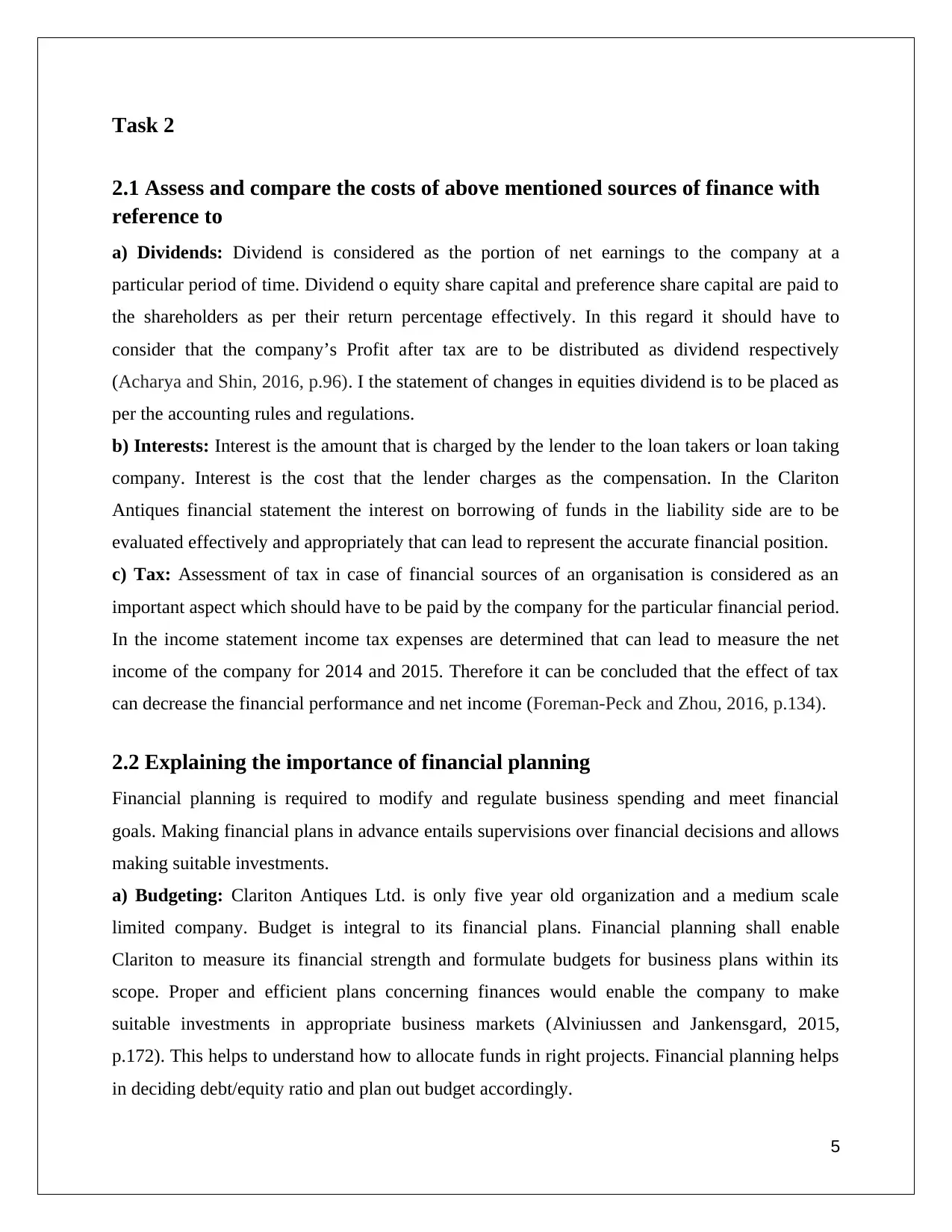
Task 2
2.1 Assess and compare the costs of above mentioned sources of finance with
reference to
a) Dividends: Dividend is considered as the portion of net earnings to the company at a
particular period of time. Dividend o equity share capital and preference share capital are paid to
the shareholders as per their return percentage effectively. In this regard it should have to
consider that the company’s Profit after tax are to be distributed as dividend respectively
(Acharya and Shin, 2016, p.96). I the statement of changes in equities dividend is to be placed as
per the accounting rules and regulations.
b) Interests: Interest is the amount that is charged by the lender to the loan takers or loan taking
company. Interest is the cost that the lender charges as the compensation. In the Clariton
Antiques financial statement the interest on borrowing of funds in the liability side are to be
evaluated effectively and appropriately that can lead to represent the accurate financial position.
c) Tax: Assessment of tax in case of financial sources of an organisation is considered as an
important aspect which should have to be paid by the company for the particular financial period.
In the income statement income tax expenses are determined that can lead to measure the net
income of the company for 2014 and 2015. Therefore it can be concluded that the effect of tax
can decrease the financial performance and net income (Foreman-Peck and Zhou, 2016, p.134).
2.2 Explaining the importance of financial planning
Financial planning is required to modify and regulate business spending and meet financial
goals. Making financial plans in advance entails supervisions over financial decisions and allows
making suitable investments.
a) Budgeting: Clariton Antiques Ltd. is only five year old organization and a medium scale
limited company. Budget is integral to its financial plans. Financial planning shall enable
Clariton to measure its financial strength and formulate budgets for business plans within its
scope. Proper and efficient plans concerning finances would enable the company to make
suitable investments in appropriate business markets (Alviniussen and Jankensgard, 2015,
p.172). This helps to understand how to allocate funds in right projects. Financial planning helps
in deciding debt/equity ratio and plan out budget accordingly.
5
2.1 Assess and compare the costs of above mentioned sources of finance with
reference to
a) Dividends: Dividend is considered as the portion of net earnings to the company at a
particular period of time. Dividend o equity share capital and preference share capital are paid to
the shareholders as per their return percentage effectively. In this regard it should have to
consider that the company’s Profit after tax are to be distributed as dividend respectively
(Acharya and Shin, 2016, p.96). I the statement of changes in equities dividend is to be placed as
per the accounting rules and regulations.
b) Interests: Interest is the amount that is charged by the lender to the loan takers or loan taking
company. Interest is the cost that the lender charges as the compensation. In the Clariton
Antiques financial statement the interest on borrowing of funds in the liability side are to be
evaluated effectively and appropriately that can lead to represent the accurate financial position.
c) Tax: Assessment of tax in case of financial sources of an organisation is considered as an
important aspect which should have to be paid by the company for the particular financial period.
In the income statement income tax expenses are determined that can lead to measure the net
income of the company for 2014 and 2015. Therefore it can be concluded that the effect of tax
can decrease the financial performance and net income (Foreman-Peck and Zhou, 2016, p.134).
2.2 Explaining the importance of financial planning
Financial planning is required to modify and regulate business spending and meet financial
goals. Making financial plans in advance entails supervisions over financial decisions and allows
making suitable investments.
a) Budgeting: Clariton Antiques Ltd. is only five year old organization and a medium scale
limited company. Budget is integral to its financial plans. Financial planning shall enable
Clariton to measure its financial strength and formulate budgets for business plans within its
scope. Proper and efficient plans concerning finances would enable the company to make
suitable investments in appropriate business markets (Alviniussen and Jankensgard, 2015,
p.172). This helps to understand how to allocate funds in right projects. Financial planning helps
in deciding debt/equity ratio and plan out budget accordingly.
5
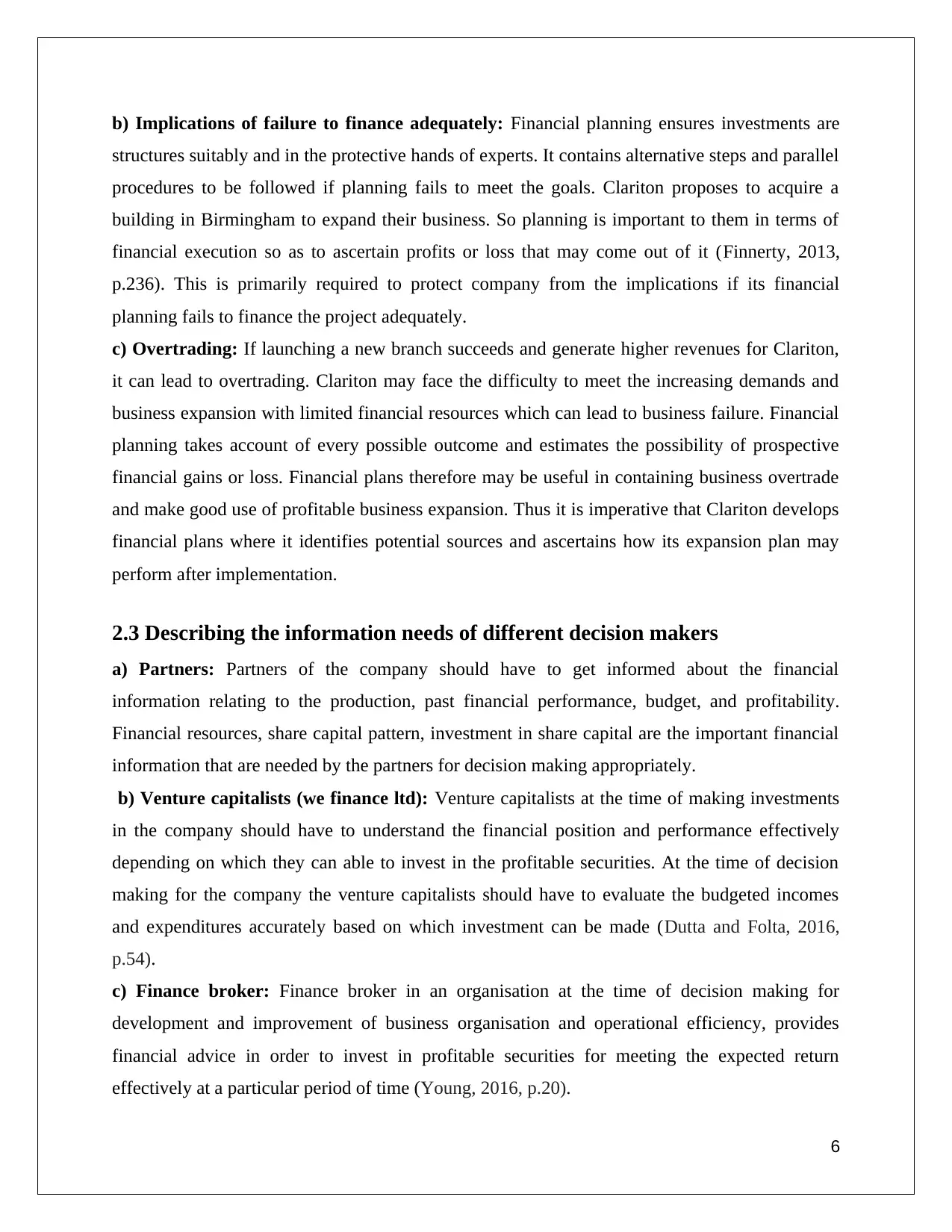
b) Implications of failure to finance adequately: Financial planning ensures investments are
structures suitably and in the protective hands of experts. It contains alternative steps and parallel
procedures to be followed if planning fails to meet the goals. Clariton proposes to acquire a
building in Birmingham to expand their business. So planning is important to them in terms of
financial execution so as to ascertain profits or loss that may come out of it (Finnerty, 2013,
p.236). This is primarily required to protect company from the implications if its financial
planning fails to finance the project adequately.
c) Overtrading: If launching a new branch succeeds and generate higher revenues for Clariton,
it can lead to overtrading. Clariton may face the difficulty to meet the increasing demands and
business expansion with limited financial resources which can lead to business failure. Financial
planning takes account of every possible outcome and estimates the possibility of prospective
financial gains or loss. Financial plans therefore may be useful in containing business overtrade
and make good use of profitable business expansion. Thus it is imperative that Clariton develops
financial plans where it identifies potential sources and ascertains how its expansion plan may
perform after implementation.
2.3 Describing the information needs of different decision makers
a) Partners: Partners of the company should have to get informed about the financial
information relating to the production, past financial performance, budget, and profitability.
Financial resources, share capital pattern, investment in share capital are the important financial
information that are needed by the partners for decision making appropriately.
b) Venture capitalists (we finance ltd): Venture capitalists at the time of making investments
in the company should have to understand the financial position and performance effectively
depending on which they can able to invest in the profitable securities. At the time of decision
making for the company the venture capitalists should have to evaluate the budgeted incomes
and expenditures accurately based on which investment can be made (Dutta and Folta, 2016,
p.54).
c) Finance broker: Finance broker in an organisation at the time of decision making for
development and improvement of business organisation and operational efficiency, provides
financial advice in order to invest in profitable securities for meeting the expected return
effectively at a particular period of time (Young, 2016, p.20).
6
structures suitably and in the protective hands of experts. It contains alternative steps and parallel
procedures to be followed if planning fails to meet the goals. Clariton proposes to acquire a
building in Birmingham to expand their business. So planning is important to them in terms of
financial execution so as to ascertain profits or loss that may come out of it (Finnerty, 2013,
p.236). This is primarily required to protect company from the implications if its financial
planning fails to finance the project adequately.
c) Overtrading: If launching a new branch succeeds and generate higher revenues for Clariton,
it can lead to overtrading. Clariton may face the difficulty to meet the increasing demands and
business expansion with limited financial resources which can lead to business failure. Financial
planning takes account of every possible outcome and estimates the possibility of prospective
financial gains or loss. Financial plans therefore may be useful in containing business overtrade
and make good use of profitable business expansion. Thus it is imperative that Clariton develops
financial plans where it identifies potential sources and ascertains how its expansion plan may
perform after implementation.
2.3 Describing the information needs of different decision makers
a) Partners: Partners of the company should have to get informed about the financial
information relating to the production, past financial performance, budget, and profitability.
Financial resources, share capital pattern, investment in share capital are the important financial
information that are needed by the partners for decision making appropriately.
b) Venture capitalists (we finance ltd): Venture capitalists at the time of making investments
in the company should have to understand the financial position and performance effectively
depending on which they can able to invest in the profitable securities. At the time of decision
making for the company the venture capitalists should have to evaluate the budgeted incomes
and expenditures accurately based on which investment can be made (Dutta and Folta, 2016,
p.54).
c) Finance broker: Finance broker in an organisation at the time of decision making for
development and improvement of business organisation and operational efficiency, provides
financial advice in order to invest in profitable securities for meeting the expected return
effectively at a particular period of time (Young, 2016, p.20).
6
⊘ This is a preview!⊘
Do you want full access?
Subscribe today to unlock all pages.

Trusted by 1+ million students worldwide
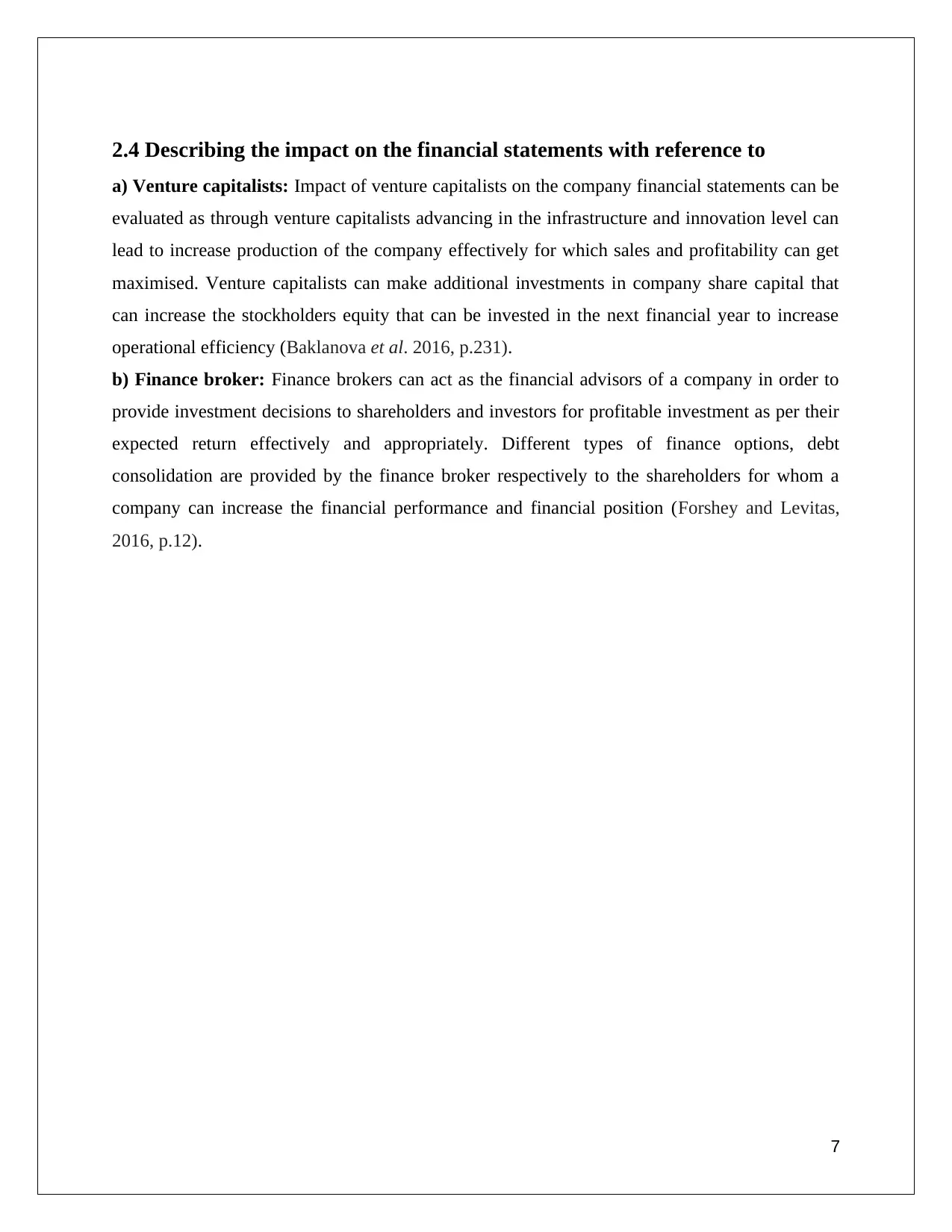
2.4 Describing the impact on the financial statements with reference to
a) Venture capitalists: Impact of venture capitalists on the company financial statements can be
evaluated as through venture capitalists advancing in the infrastructure and innovation level can
lead to increase production of the company effectively for which sales and profitability can get
maximised. Venture capitalists can make additional investments in company share capital that
can increase the stockholders equity that can be invested in the next financial year to increase
operational efficiency (Baklanova et al. 2016, p.231).
b) Finance broker: Finance brokers can act as the financial advisors of a company in order to
provide investment decisions to shareholders and investors for profitable investment as per their
expected return effectively and appropriately. Different types of finance options, debt
consolidation are provided by the finance broker respectively to the shareholders for whom a
company can increase the financial performance and financial position (Forshey and Levitas,
2016, p.12).
7
a) Venture capitalists: Impact of venture capitalists on the company financial statements can be
evaluated as through venture capitalists advancing in the infrastructure and innovation level can
lead to increase production of the company effectively for which sales and profitability can get
maximised. Venture capitalists can make additional investments in company share capital that
can increase the stockholders equity that can be invested in the next financial year to increase
operational efficiency (Baklanova et al. 2016, p.231).
b) Finance broker: Finance brokers can act as the financial advisors of a company in order to
provide investment decisions to shareholders and investors for profitable investment as per their
expected return effectively and appropriately. Different types of finance options, debt
consolidation are provided by the finance broker respectively to the shareholders for whom a
company can increase the financial performance and financial position (Forshey and Levitas,
2016, p.12).
7
Paraphrase This Document
Need a fresh take? Get an instant paraphrase of this document with our AI Paraphraser
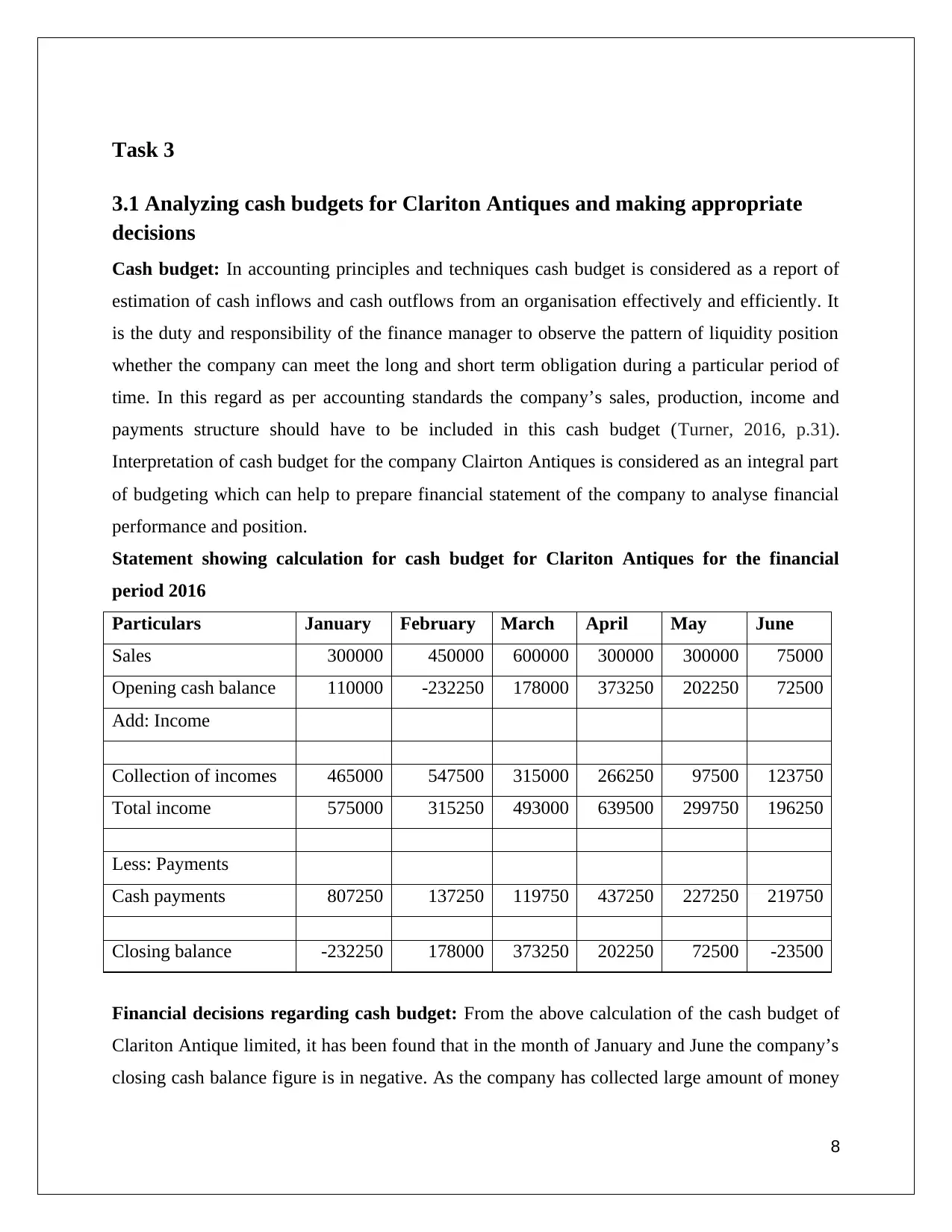
Task 3
3.1 Analyzing cash budgets for Clariton Antiques and making appropriate
decisions
Cash budget: In accounting principles and techniques cash budget is considered as a report of
estimation of cash inflows and cash outflows from an organisation effectively and efficiently. It
is the duty and responsibility of the finance manager to observe the pattern of liquidity position
whether the company can meet the long and short term obligation during a particular period of
time. In this regard as per accounting standards the company’s sales, production, income and
payments structure should have to be included in this cash budget (Turner, 2016, p.31).
Interpretation of cash budget for the company Clairton Antiques is considered as an integral part
of budgeting which can help to prepare financial statement of the company to analyse financial
performance and position.
Statement showing calculation for cash budget for Clariton Antiques for the financial
period 2016
Particulars January February March April May June
Sales 300000 450000 600000 300000 300000 75000
Opening cash balance 110000 -232250 178000 373250 202250 72500
Add: Income
Collection of incomes 465000 547500 315000 266250 97500 123750
Total income 575000 315250 493000 639500 299750 196250
Less: Payments
Cash payments 807250 137250 119750 437250 227250 219750
Closing balance -232250 178000 373250 202250 72500 -23500
Financial decisions regarding cash budget: From the above calculation of the cash budget of
Clariton Antique limited, it has been found that in the month of January and June the company’s
closing cash balance figure is in negative. As the company has collected large amount of money
8
3.1 Analyzing cash budgets for Clariton Antiques and making appropriate
decisions
Cash budget: In accounting principles and techniques cash budget is considered as a report of
estimation of cash inflows and cash outflows from an organisation effectively and efficiently. It
is the duty and responsibility of the finance manager to observe the pattern of liquidity position
whether the company can meet the long and short term obligation during a particular period of
time. In this regard as per accounting standards the company’s sales, production, income and
payments structure should have to be included in this cash budget (Turner, 2016, p.31).
Interpretation of cash budget for the company Clairton Antiques is considered as an integral part
of budgeting which can help to prepare financial statement of the company to analyse financial
performance and position.
Statement showing calculation for cash budget for Clariton Antiques for the financial
period 2016
Particulars January February March April May June
Sales 300000 450000 600000 300000 300000 75000
Opening cash balance 110000 -232250 178000 373250 202250 72500
Add: Income
Collection of incomes 465000 547500 315000 266250 97500 123750
Total income 575000 315250 493000 639500 299750 196250
Less: Payments
Cash payments 807250 137250 119750 437250 227250 219750
Closing balance -232250 178000 373250 202250 72500 -23500
Financial decisions regarding cash budget: From the above calculation of the cash budget of
Clariton Antique limited, it has been found that in the month of January and June the company’s
closing cash balance figure is in negative. As the company has collected large amount of money
8
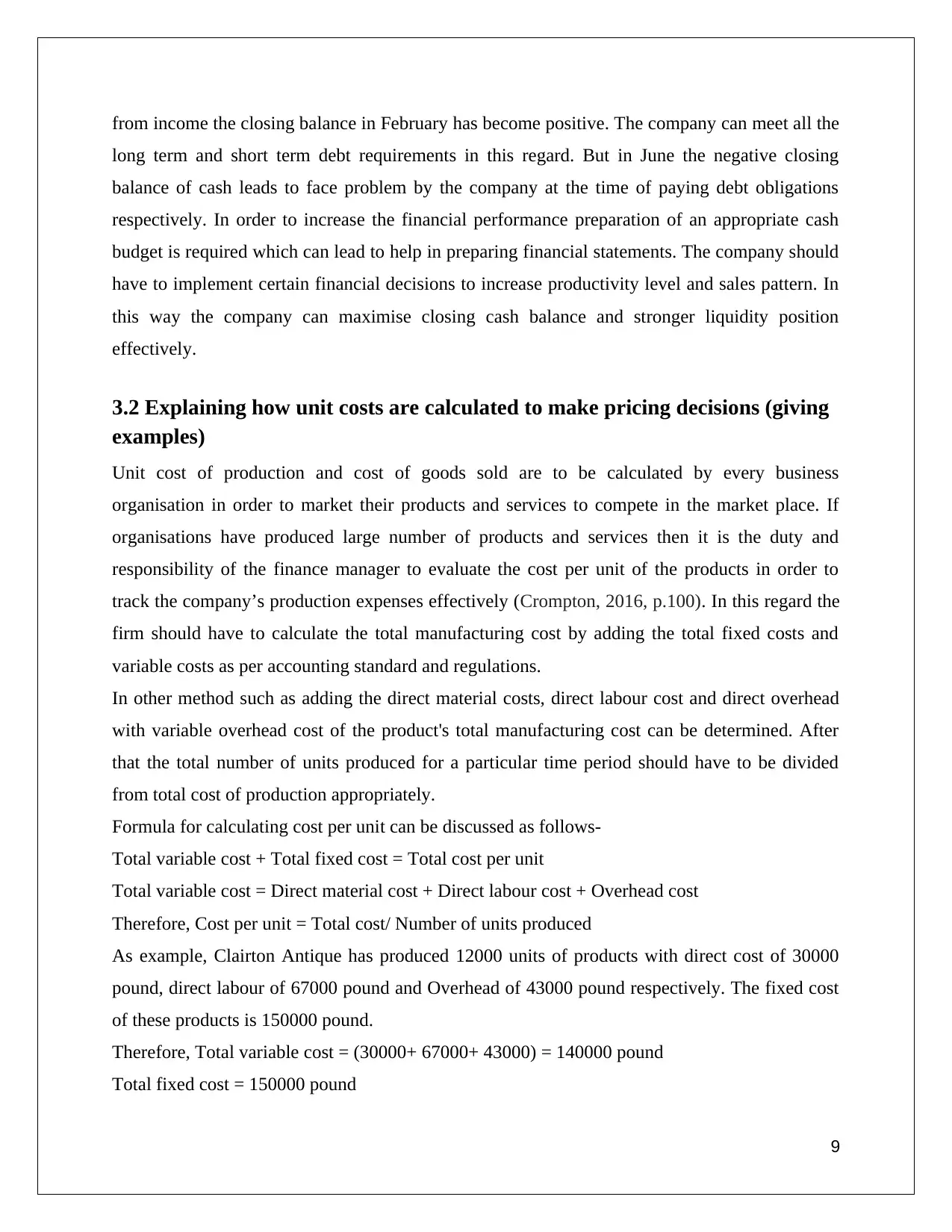
from income the closing balance in February has become positive. The company can meet all the
long term and short term debt requirements in this regard. But in June the negative closing
balance of cash leads to face problem by the company at the time of paying debt obligations
respectively. In order to increase the financial performance preparation of an appropriate cash
budget is required which can lead to help in preparing financial statements. The company should
have to implement certain financial decisions to increase productivity level and sales pattern. In
this way the company can maximise closing cash balance and stronger liquidity position
effectively.
3.2 Explaining how unit costs are calculated to make pricing decisions (giving
examples)
Unit cost of production and cost of goods sold are to be calculated by every business
organisation in order to market their products and services to compete in the market place. If
organisations have produced large number of products and services then it is the duty and
responsibility of the finance manager to evaluate the cost per unit of the products in order to
track the company’s production expenses effectively (Crompton, 2016, p.100). In this regard the
firm should have to calculate the total manufacturing cost by adding the total fixed costs and
variable costs as per accounting standard and regulations.
In other method such as adding the direct material costs, direct labour cost and direct overhead
with variable overhead cost of the product's total manufacturing cost can be determined. After
that the total number of units produced for a particular time period should have to be divided
from total cost of production appropriately.
Formula for calculating cost per unit can be discussed as follows-
Total variable cost + Total fixed cost = Total cost per unit
Total variable cost = Direct material cost + Direct labour cost + Overhead cost
Therefore, Cost per unit = Total cost/ Number of units produced
As example, Clairton Antique has produced 12000 units of products with direct cost of 30000
pound, direct labour of 67000 pound and Overhead of 43000 pound respectively. The fixed cost
of these products is 150000 pound.
Therefore, Total variable cost = (30000+ 67000+ 43000) = 140000 pound
Total fixed cost = 150000 pound
9
long term and short term debt requirements in this regard. But in June the negative closing
balance of cash leads to face problem by the company at the time of paying debt obligations
respectively. In order to increase the financial performance preparation of an appropriate cash
budget is required which can lead to help in preparing financial statements. The company should
have to implement certain financial decisions to increase productivity level and sales pattern. In
this way the company can maximise closing cash balance and stronger liquidity position
effectively.
3.2 Explaining how unit costs are calculated to make pricing decisions (giving
examples)
Unit cost of production and cost of goods sold are to be calculated by every business
organisation in order to market their products and services to compete in the market place. If
organisations have produced large number of products and services then it is the duty and
responsibility of the finance manager to evaluate the cost per unit of the products in order to
track the company’s production expenses effectively (Crompton, 2016, p.100). In this regard the
firm should have to calculate the total manufacturing cost by adding the total fixed costs and
variable costs as per accounting standard and regulations.
In other method such as adding the direct material costs, direct labour cost and direct overhead
with variable overhead cost of the product's total manufacturing cost can be determined. After
that the total number of units produced for a particular time period should have to be divided
from total cost of production appropriately.
Formula for calculating cost per unit can be discussed as follows-
Total variable cost + Total fixed cost = Total cost per unit
Total variable cost = Direct material cost + Direct labour cost + Overhead cost
Therefore, Cost per unit = Total cost/ Number of units produced
As example, Clairton Antique has produced 12000 units of products with direct cost of 30000
pound, direct labour of 67000 pound and Overhead of 43000 pound respectively. The fixed cost
of these products is 150000 pound.
Therefore, Total variable cost = (30000+ 67000+ 43000) = 140000 pound
Total fixed cost = 150000 pound
9
⊘ This is a preview!⊘
Do you want full access?
Subscribe today to unlock all pages.

Trusted by 1+ million students worldwide
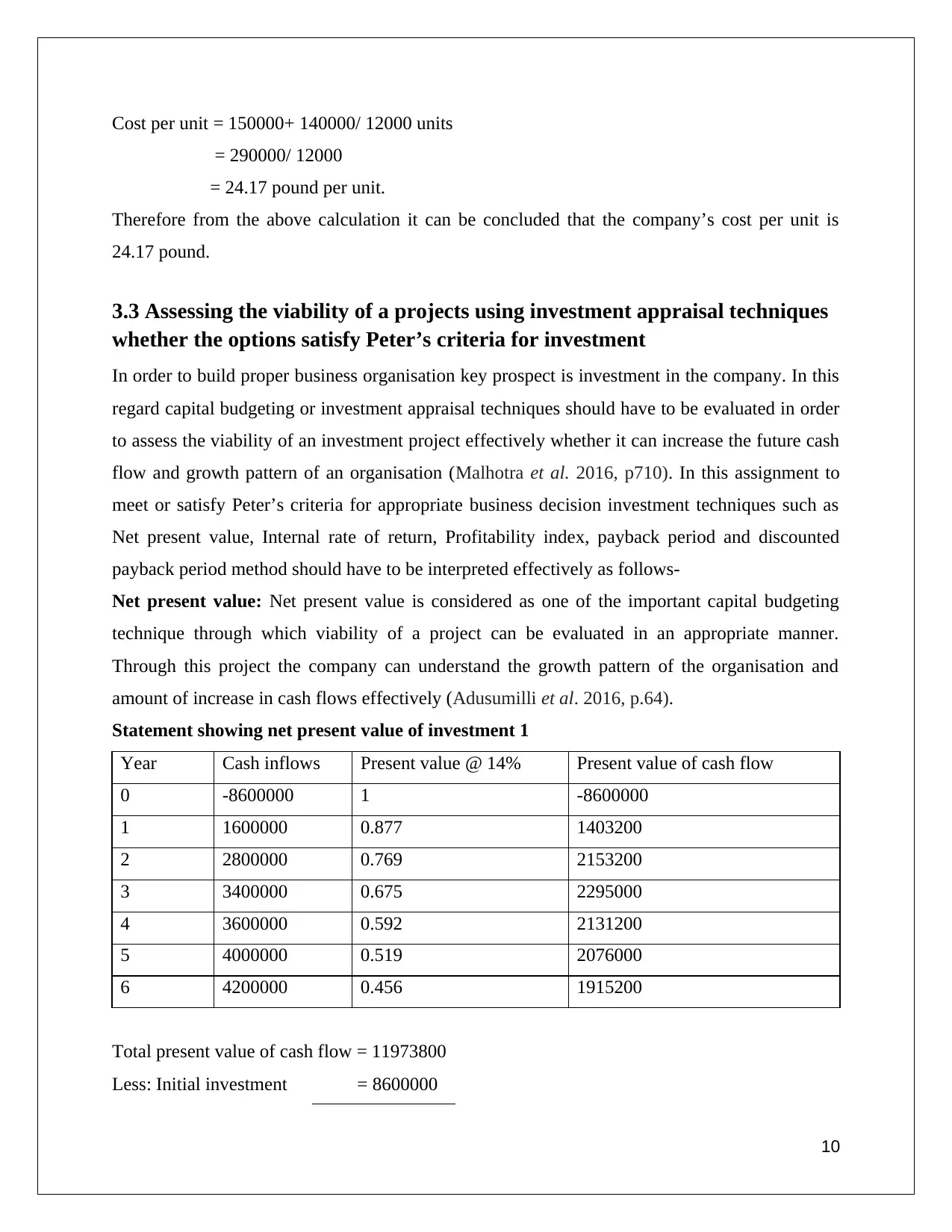
Cost per unit = 150000+ 140000/ 12000 units
= 290000/ 12000
= 24.17 pound per unit.
Therefore from the above calculation it can be concluded that the company’s cost per unit is
24.17 pound.
3.3 Assessing the viability of a projects using investment appraisal techniques
whether the options satisfy Peter’s criteria for investment
In order to build proper business organisation key prospect is investment in the company. In this
regard capital budgeting or investment appraisal techniques should have to be evaluated in order
to assess the viability of an investment project effectively whether it can increase the future cash
flow and growth pattern of an organisation (Malhotra et al. 2016, p710). In this assignment to
meet or satisfy Peter’s criteria for appropriate business decision investment techniques such as
Net present value, Internal rate of return, Profitability index, payback period and discounted
payback period method should have to be interpreted effectively as follows-
Net present value: Net present value is considered as one of the important capital budgeting
technique through which viability of a project can be evaluated in an appropriate manner.
Through this project the company can understand the growth pattern of the organisation and
amount of increase in cash flows effectively (Adusumilli et al. 2016, p.64).
Statement showing net present value of investment 1
Year Cash inflows Present value @ 14% Present value of cash flow
0 -8600000 1 -8600000
1 1600000 0.877 1403200
2 2800000 0.769 2153200
3 3400000 0.675 2295000
4 3600000 0.592 2131200
5 4000000 0.519 2076000
6 4200000 0.456 1915200
Total present value of cash flow = 11973800
Less: Initial investment = 8600000
10
= 290000/ 12000
= 24.17 pound per unit.
Therefore from the above calculation it can be concluded that the company’s cost per unit is
24.17 pound.
3.3 Assessing the viability of a projects using investment appraisal techniques
whether the options satisfy Peter’s criteria for investment
In order to build proper business organisation key prospect is investment in the company. In this
regard capital budgeting or investment appraisal techniques should have to be evaluated in order
to assess the viability of an investment project effectively whether it can increase the future cash
flow and growth pattern of an organisation (Malhotra et al. 2016, p710). In this assignment to
meet or satisfy Peter’s criteria for appropriate business decision investment techniques such as
Net present value, Internal rate of return, Profitability index, payback period and discounted
payback period method should have to be interpreted effectively as follows-
Net present value: Net present value is considered as one of the important capital budgeting
technique through which viability of a project can be evaluated in an appropriate manner.
Through this project the company can understand the growth pattern of the organisation and
amount of increase in cash flows effectively (Adusumilli et al. 2016, p.64).
Statement showing net present value of investment 1
Year Cash inflows Present value @ 14% Present value of cash flow
0 -8600000 1 -8600000
1 1600000 0.877 1403200
2 2800000 0.769 2153200
3 3400000 0.675 2295000
4 3600000 0.592 2131200
5 4000000 0.519 2076000
6 4200000 0.456 1915200
Total present value of cash flow = 11973800
Less: Initial investment = 8600000
10
Paraphrase This Document
Need a fresh take? Get an instant paraphrase of this document with our AI Paraphraser
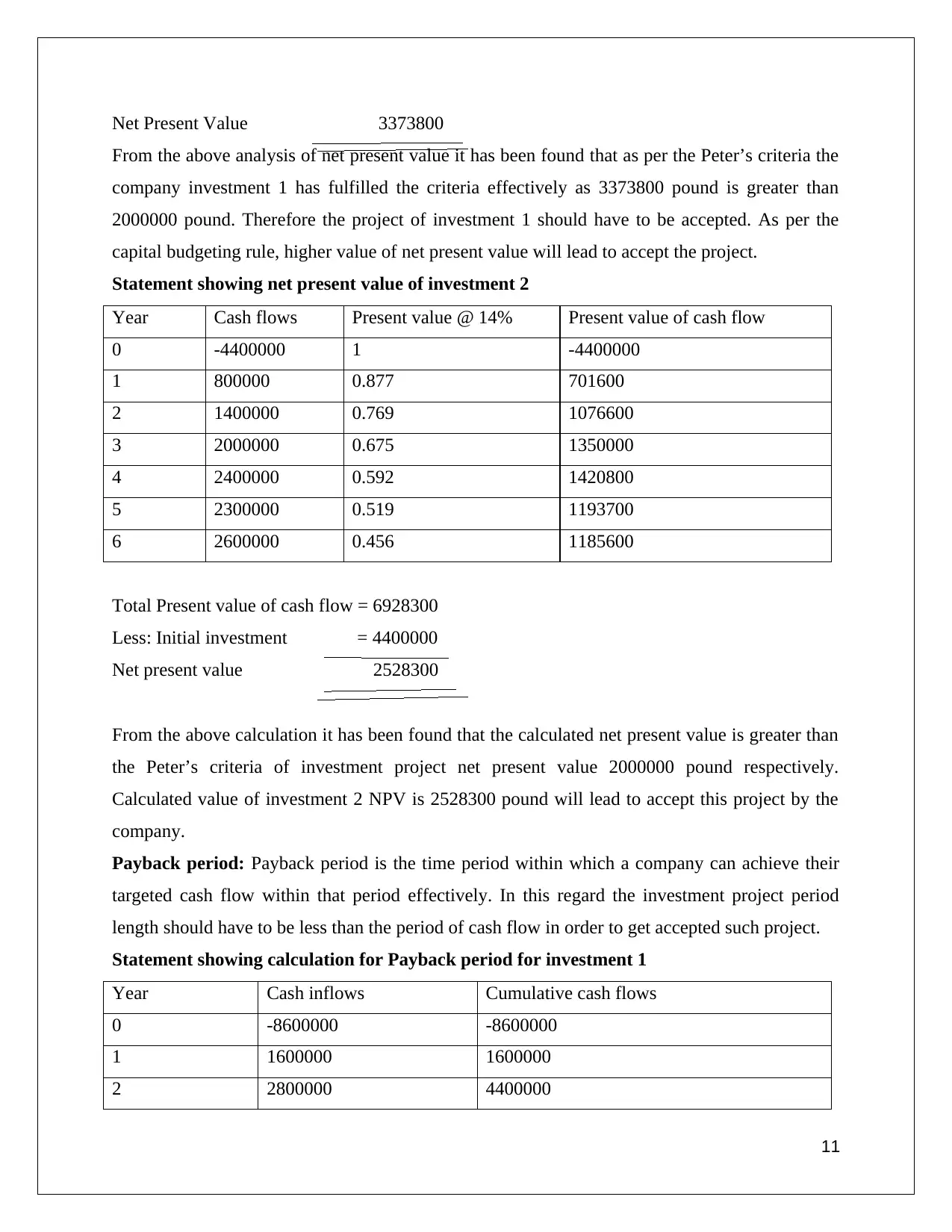
Net Present Value 3373800
From the above analysis of net present value it has been found that as per the Peter’s criteria the
company investment 1 has fulfilled the criteria effectively as 3373800 pound is greater than
2000000 pound. Therefore the project of investment 1 should have to be accepted. As per the
capital budgeting rule, higher value of net present value will lead to accept the project.
Statement showing net present value of investment 2
Year Cash flows Present value @ 14% Present value of cash flow
0 -4400000 1 -4400000
1 800000 0.877 701600
2 1400000 0.769 1076600
3 2000000 0.675 1350000
4 2400000 0.592 1420800
5 2300000 0.519 1193700
6 2600000 0.456 1185600
Total Present value of cash flow = 6928300
Less: Initial investment = 4400000
Net present value 2528300
From the above calculation it has been found that the calculated net present value is greater than
the Peter’s criteria of investment project net present value 2000000 pound respectively.
Calculated value of investment 2 NPV is 2528300 pound will lead to accept this project by the
company.
Payback period: Payback period is the time period within which a company can achieve their
targeted cash flow within that period effectively. In this regard the investment project period
length should have to be less than the period of cash flow in order to get accepted such project.
Statement showing calculation for Payback period for investment 1
Year Cash inflows Cumulative cash flows
0 -8600000 -8600000
1 1600000 1600000
2 2800000 4400000
11
From the above analysis of net present value it has been found that as per the Peter’s criteria the
company investment 1 has fulfilled the criteria effectively as 3373800 pound is greater than
2000000 pound. Therefore the project of investment 1 should have to be accepted. As per the
capital budgeting rule, higher value of net present value will lead to accept the project.
Statement showing net present value of investment 2
Year Cash flows Present value @ 14% Present value of cash flow
0 -4400000 1 -4400000
1 800000 0.877 701600
2 1400000 0.769 1076600
3 2000000 0.675 1350000
4 2400000 0.592 1420800
5 2300000 0.519 1193700
6 2600000 0.456 1185600
Total Present value of cash flow = 6928300
Less: Initial investment = 4400000
Net present value 2528300
From the above calculation it has been found that the calculated net present value is greater than
the Peter’s criteria of investment project net present value 2000000 pound respectively.
Calculated value of investment 2 NPV is 2528300 pound will lead to accept this project by the
company.
Payback period: Payback period is the time period within which a company can achieve their
targeted cash flow within that period effectively. In this regard the investment project period
length should have to be less than the period of cash flow in order to get accepted such project.
Statement showing calculation for Payback period for investment 1
Year Cash inflows Cumulative cash flows
0 -8600000 -8600000
1 1600000 1600000
2 2800000 4400000
11
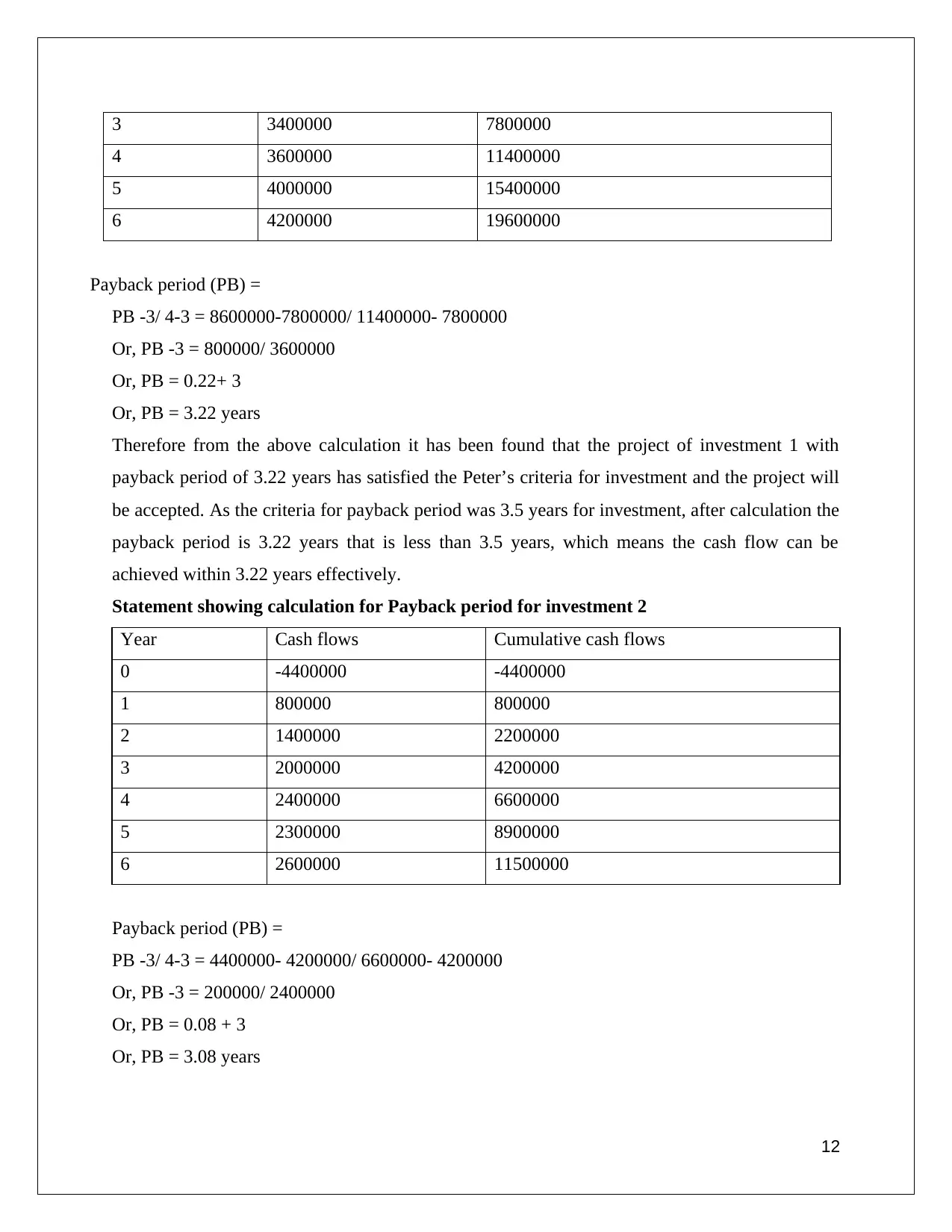
3 3400000 7800000
4 3600000 11400000
5 4000000 15400000
6 4200000 19600000
Payback period (PB) =
PB -3/ 4-3 = 8600000-7800000/ 11400000- 7800000
Or, PB -3 = 800000/ 3600000
Or, PB = 0.22+ 3
Or, PB = 3.22 years
Therefore from the above calculation it has been found that the project of investment 1 with
payback period of 3.22 years has satisfied the Peter’s criteria for investment and the project will
be accepted. As the criteria for payback period was 3.5 years for investment, after calculation the
payback period is 3.22 years that is less than 3.5 years, which means the cash flow can be
achieved within 3.22 years effectively.
Statement showing calculation for Payback period for investment 2
Year Cash flows Cumulative cash flows
0 -4400000 -4400000
1 800000 800000
2 1400000 2200000
3 2000000 4200000
4 2400000 6600000
5 2300000 8900000
6 2600000 11500000
Payback period (PB) =
PB -3/ 4-3 = 4400000- 4200000/ 6600000- 4200000
Or, PB -3 = 200000/ 2400000
Or, PB = 0.08 + 3
Or, PB = 3.08 years
12
4 3600000 11400000
5 4000000 15400000
6 4200000 19600000
Payback period (PB) =
PB -3/ 4-3 = 8600000-7800000/ 11400000- 7800000
Or, PB -3 = 800000/ 3600000
Or, PB = 0.22+ 3
Or, PB = 3.22 years
Therefore from the above calculation it has been found that the project of investment 1 with
payback period of 3.22 years has satisfied the Peter’s criteria for investment and the project will
be accepted. As the criteria for payback period was 3.5 years for investment, after calculation the
payback period is 3.22 years that is less than 3.5 years, which means the cash flow can be
achieved within 3.22 years effectively.
Statement showing calculation for Payback period for investment 2
Year Cash flows Cumulative cash flows
0 -4400000 -4400000
1 800000 800000
2 1400000 2200000
3 2000000 4200000
4 2400000 6600000
5 2300000 8900000
6 2600000 11500000
Payback period (PB) =
PB -3/ 4-3 = 4400000- 4200000/ 6600000- 4200000
Or, PB -3 = 200000/ 2400000
Or, PB = 0.08 + 3
Or, PB = 3.08 years
12
⊘ This is a preview!⊘
Do you want full access?
Subscribe today to unlock all pages.

Trusted by 1+ million students worldwide
1 out of 20
Related Documents
Your All-in-One AI-Powered Toolkit for Academic Success.
+13062052269
info@desklib.com
Available 24*7 on WhatsApp / Email
![[object Object]](/_next/static/media/star-bottom.7253800d.svg)
Unlock your academic potential
Copyright © 2020–2025 A2Z Services. All Rights Reserved. Developed and managed by ZUCOL.





